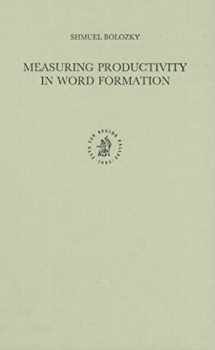
Measuring Productivity in Word Formation: The Case of Israeli Hebrew (Studies in Semitic Languages and Linguistics)
ISBN-13:
9789004112520
ISBN-10:
9004112529
Author:
Shmuel Bolozky
Publication date:
1999
Publisher:
Brill
Format:
Hardcover
253 pages
FREE US shipping
on ALL non-marketplace orders
Marketplace
from $85.41
USD
Marketplace offers
Seller
Condition
Note
Seller
Condition
New
Seller
Condition
Used - Like New
Sealed in original plastic
Seller
Condition
Used - Like New
Brand New! Sealed in publisher's shrinkwrap. Never opened! No signs of wear.
Seller
Condition
Used - Like New
Brand new! Still sealed in plastic.
Seller
Condition
New
Seller
Condition
New
Book details
ISBN-13:
9789004112520
ISBN-10:
9004112529
Author:
Shmuel Bolozky
Publication date:
1999
Publisher:
Brill
Format:
Hardcover
253 pages
Summary
Measuring Productivity in Word Formation: The Case of Israeli Hebrew (Studies in Semitic Languages and Linguistics) (ISBN-13: 9789004112520 and ISBN-10: 9004112529), written by authors
Shmuel Bolozky, was published by Brill in 1999.
With an overall rating of 3.8 stars, it's a notable title among other
books. You can easily purchase or rent Measuring Productivity in Word Formation: The Case of Israeli Hebrew (Studies in Semitic Languages and Linguistics) (Hardcover) from BooksRun,
along with many other new and used
books
and textbooks.
And, if you're looking to sell your copy, our current buyback offer is $0.3.
Description
Morphological productivity is the likelihood of a morphological pattern being used or comprehended in new word formation. Three methods of measuring productivity of word formation are proposed productivity tests (open-ended and judgment tasks), dictionary comparison (newer with older dictionaries, supplements with earlier versions), and the ratio of hapax legomena to tokens in corpora. Processes which score highly by all three criteria can safely be regarded as productive. The model is examined in light of data from Israeli Hebrew, which as a Semitic language offers a rich array of discontinuous and linear derivation patterns. The Hebrew data also support the claims that in essence, lexical formation is semantically based; that it is constrained by a requirement for distinctiveness; and that it may vary significantly with the type of derivation base.


We would LOVE it if you could help us and other readers by reviewing the book
Book review

Congratulations! We have received your book review.
{user}
{createdAt}
by {truncated_author}


